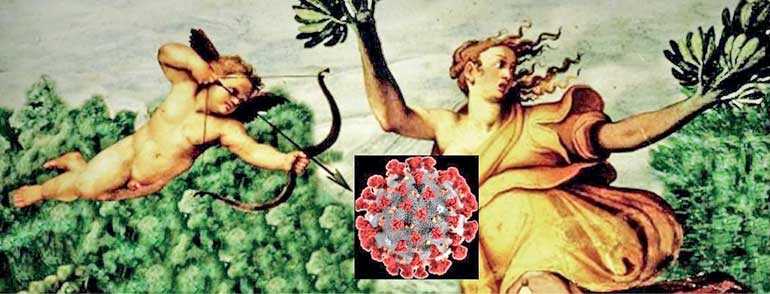Friday Dec 12, 2025
Friday Dec 12, 2025
Monday, 10 February 2020 00:14 - - {{hitsCtrl.values.hits}}

The Cupid, typically depicted as a ‘cherubic, winged infant wielding a bow and arrow’, was known to Greeks as Eros. He struck at the hearts of others in playing with their emotions
Fear and anixiety since the coronavirus outbreak is spreading across the globe. The love and romance associated with Valentine’s Day is somewhat subdued this year due to health alerts. Having celebrated 72 years of Independence last week as an island of ingenuity, we need to stay positive with a pragmatic approach on all fronts. One essential requisite for such an endeavour is emotional maturity.
Overview
The Cupid, typically depicted as a ‘cherubic, winged infant wielding a bow and arrow’, was known to Greeks as Eros. He struck at the hearts of others in playing with their emotions. In one such case, Cupid shot a golden arrow at Apollo, who fell madly in love with the fairy named Daphne. Then he launched a leaden arrow at Daphne so she would be repulsed by him. He is quite popular during the season surrounding Valentine’s Day. 
Saint Valentine of Rome is a lesser-known figure, with questionable recognition by the Catholic Church. Yet, his name has become popular because of Valentine’s Day, or 14 February, every year. Despite many historical confusions, his caring for others till he was murdered because of his faith is a solid fact. Associating his good name as a martyr to represent sacrificial love is a good thing. Whether promoting Valentine’s Day for commercial purposes is a good thing or not is questionable. Of course, in our routine, diarised lives, we might need a day to remember our romantic relationships, and that could be a justification for having an annual celebration.
Emotions explored
Emotions are part and parcel of our daily life. It reminds me of something Aristotle stated a long time ago: “Anyone can become angry. That is easy. But to be angry with the right person, to the right degree, at the right time, for the right purpose, and in the right way, that is not easy.” He vividly stresses the importance of emotional control. We see how it is often violated in many occasions as communicated by printed, electronic and social media. What are emotions then? Let’s explore.
One may become angry. That’s psychological. One may become hungry. That’s physiological. Both are emotions. They can be related to mental or physical aspects. I would break the word emotion as “e –motion” or “enabling motion”. Emotions drive us for actions. In essence, they are feelings and their associated thoughts. “Rule your feelings, lest your feelings rule you”, so said Publilius Syrus, way back in the first century (B.C.). Essentially, emotions are intense feelings directed at someone or something.
At a time when the whole world is concerned about the current outbreak of the novel coronavirus (2019-nCoV) that was first reported from Wuhan, China, on 31 December 2019, what we need is more precaution leading to prevention
Stephen Robins, a veteran in organisational behaviour, presents the six key basic emotions; namely, anger, fear, sadness, happiness, disgust and surprise. You can clearly see more negatives than positives. That’s why we have more misery then mercy, providing enough business to psychiatrists. I still remember Robert Holden, who goes around the globe giving motivational speeches and calls himself a ‘recovering psychologist’. The need here is to have a more positive, pragmatic and progressive outlook.
As such, emotions can be constructive or destructive. Joy can be constructive whilst jealousy can be destructive. Channelling emotions towards success is the challenging task. The best example I can give is how the All Blacks – the New Zealand Rugby Team – perform the ritual of haka, a traditional Maori tribal war dance, just before a game begins. Hypes them up to go for the “kill”.
Emotions are still being scientifically explored. Antonioi Damasio, an expert in neuroscience, had this to say: “Emotions are bio-regulatory reactions that aim at promoting, directly or indirectly, the sort of psychological states that secure not just survival, but survival regulated into the range that we identify with well-being.”
Being emotionally intelligent
There are many myths about emotional intelligence (EI). Some say it was invented by Americans. The truth is that it has existed within human beings since time immemorial. All great religious leaders were obviously emotionally intelligent. Take the case of Buddha, who kept on meditating whilst three demons (Thanha, Rathi, and Raga) attempted to lure him with a dance. Same with Jesus when self-pity was overcome in carrying the cross to Calvary. Great leaders, such as Mahatma Gandhi, Nelson Mandela and Saint Mother Theresa, amply demonstrated EI in many ways.
It was Charles Darwin who first wrote about emotions in the western perspective. He published a book titled ‘The Expression of the Emotions in Man and Animals’ way back in 1872, highlighting genetically determined aspects of behaviour. The way I see it, EI was re-packaged in the west as a management concept.
One may become angry. That’s psychological. One may become hungry. That’s physiological. Both are emotions. They can be related to mental or physical aspects
"People high in EI are expected to progress more quickly through the abilities designated and to master more of them,” said John Mayer of New Hampshire University and Peter Salovey of Yale University, who are regarded as the co-founders of EI in its new form.
Credit should go to Daniel Goleman for sharing the concept of EI to a wider audience. His several books on EI have shed a lot of light on the matter. “Rational intelligence and technical skills are important, but emotional intelligence is the sine qua non of leadership,” opined Goleman.
In essence, EI can be viewed as a capacity. It is a capacity for recognising our own feelings and those of others, for motivating ourselves, and for managing emotions well in ourselves and in our relationships (Goleman, 1995). He re-packaged his five components as a model having four key aspects connecting self vs. others in one axis, and recognition vs. regulation in the other axis. It will be worthwhile reflecting on ourselves with regard to these four key aspects.
Self-awareness (self + recognition)
This refers to the awareness of one’s emotional state. It means the ability to recognise and understand your emotions and their effects on others. As Goleman observes, a high degree of self-confidence and a realistic self-assessment can be considered as hallmarks of people having a high level of self-awareness. I think it is directly relevant to mindfulness. ‘Sathiya’ or ‘sihiya’ in local vernacular could be the best descriptors.
Do our leaders demonstrate self-awareness? Are they conscious of what they had uttered a few days ago that was widely publicised by the media, before callously denying that they actually did so? It is a common issue in political fronts but may also happen in business and other fronts.
Self-management (self + regulation)
This is logically the second step. It refers to the ability to control or redirect disruptive impulses, in taking charge of you. According to Goleman, trustworthiness, integrity, comfort with ambiguity, and openness to change are all hallmarks of self-management.
This is also where passion comes to the surface. It refers to the propensity to pursue a purpose with persistence. The point here is that self-motivation should be beyond monetary gains or status grabs, and is about being clear about what one really wants in life. Organisational commitment has a close connection with such behaviours. Optimism even in failure can be one hallmark of such self-motivators.
This, of course, is more evident amongst many prominent leaders in the way they peruse their goals. Whether such goals are congruent with a collaborative approach towards national development is the question. A statesman can be clearly separated from a politician, based on the self-motivation towards serving the nation.
Social awareness (others + recognition)
This quadrant takes us to focus on others. It includes empathy, which is the ability to understand the emotional makeup of other people. In essence, it involves walking with ‘their shoes on’. Stephen Covey, in his popular ‘Seven Habits of Highly Effective People’, refers to this as “seek first to understand and then to be understood”. In fact, he says it is one of the often-neglected aspects of managerial behaviour around the world. Customer care, employee-sensitivity, and cross-cultural communications are some areas where empathy is a must.
Do we see leaders demonstrating empathy in our societies? Having one-sided views and thereby jumping into conclusions is quite common. Disputes often arise when empathy is discarded. Social media is abundant with such sad situations involving leaders.
Relationship management (others + regulation)
This is the culmination of all above. It refers to building lasting relationships. Being friendly, trustworthy and genuine may result in good social networks and solid teams. The acid test of EI is how good you are in successful and sustained relationships.
How do we see relationships amongst our leaders in many fronts? Are they genuine or opportunistic in their associations and affiliations? Do leaders use their high EI for relationship building or low EI for relationship busting? These are the questions we need to answer.
Way forward
“Tenderness and kindness are not signs of weakness and despair, but manifestations of strength and resolution,” said Kahlil Gibran. At a time when the whole world is concerned about the current outbreak of the novel coronavirus (2019-nCoV) that was first reported from Wuhan, China, on 31 December 2019, what we need is more precaution leading to prevention.
The world has overcome many such health epidemics in the past with the required professional approach. Emotional maturity is a good starting point.
Rather than cursing the darkness, let’s light a candle. Actions speak louder than words. In such a case, Cupid will not be disappointed with coronavirus and Valentine’s Day will not be vandalised.
(Prof. Ajantha S. Dharmasiri can be reached through [email protected], [email protected] or www.ajanthadharmasiri.info)